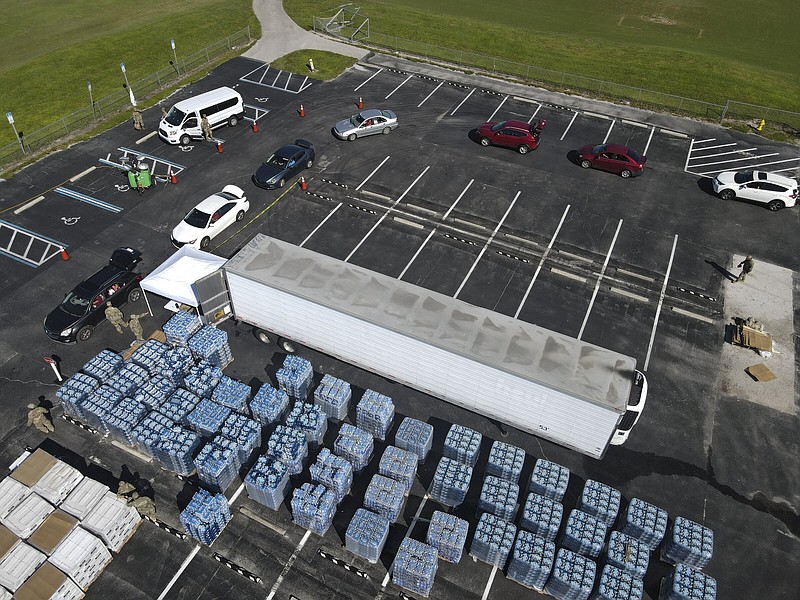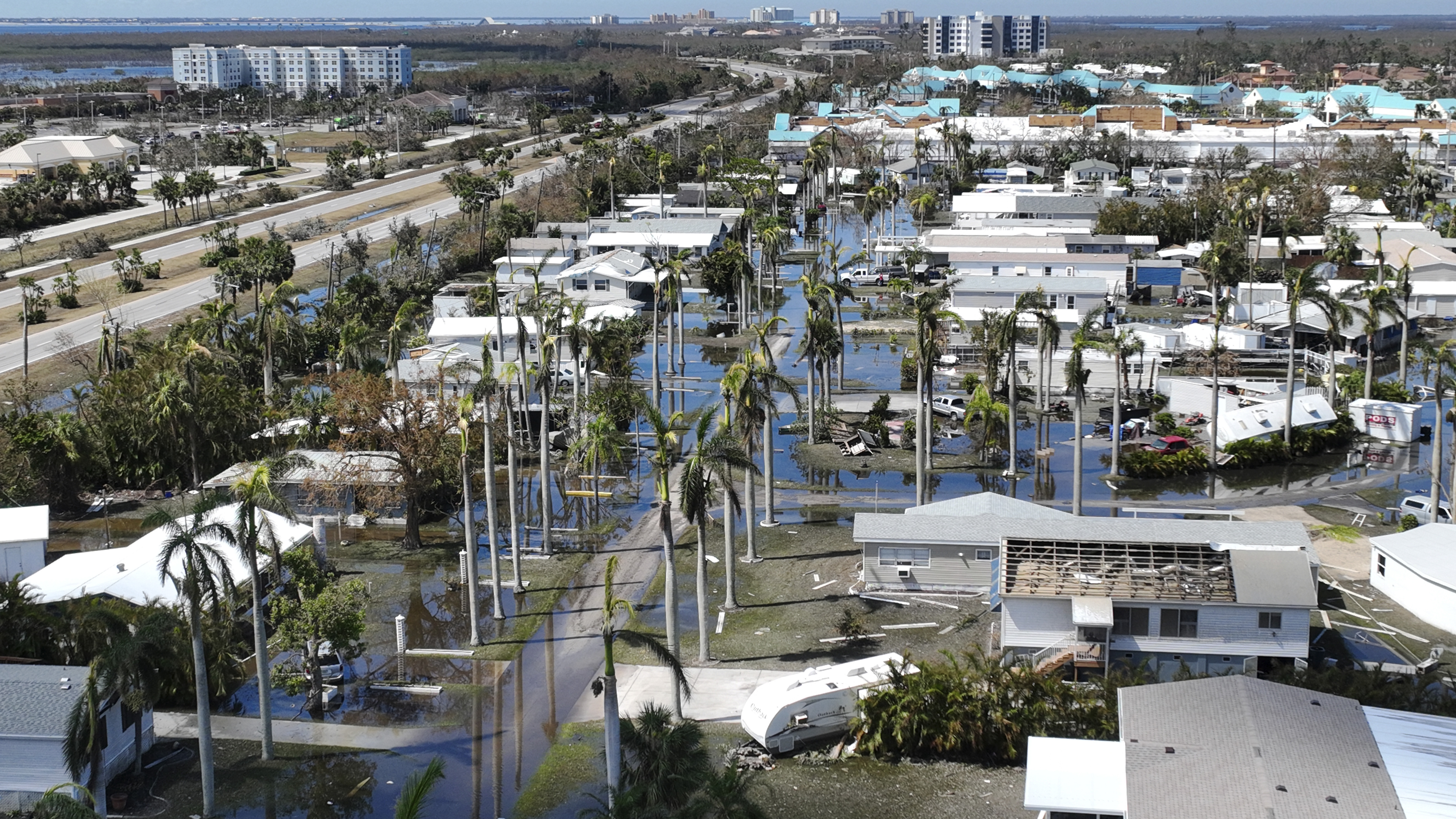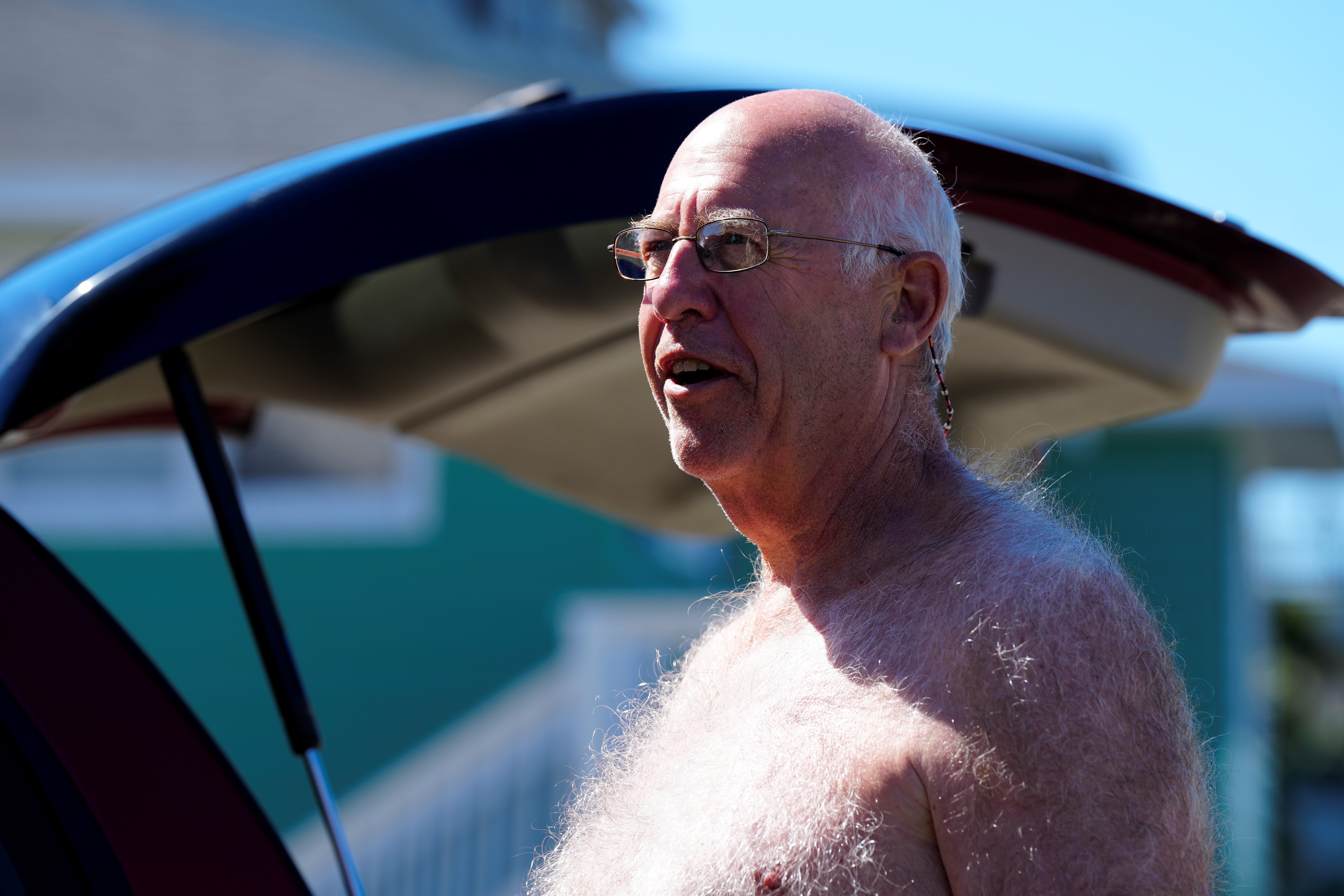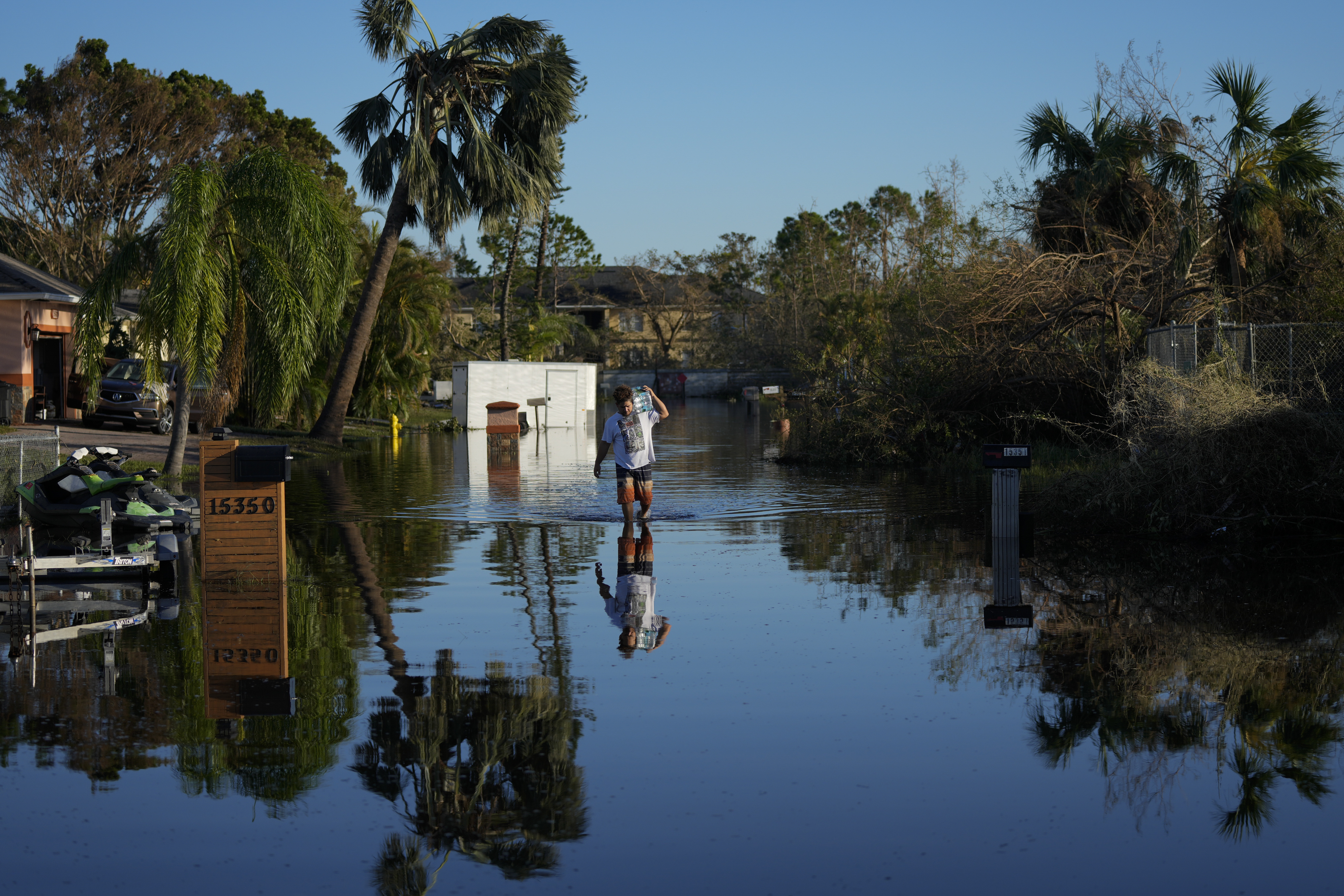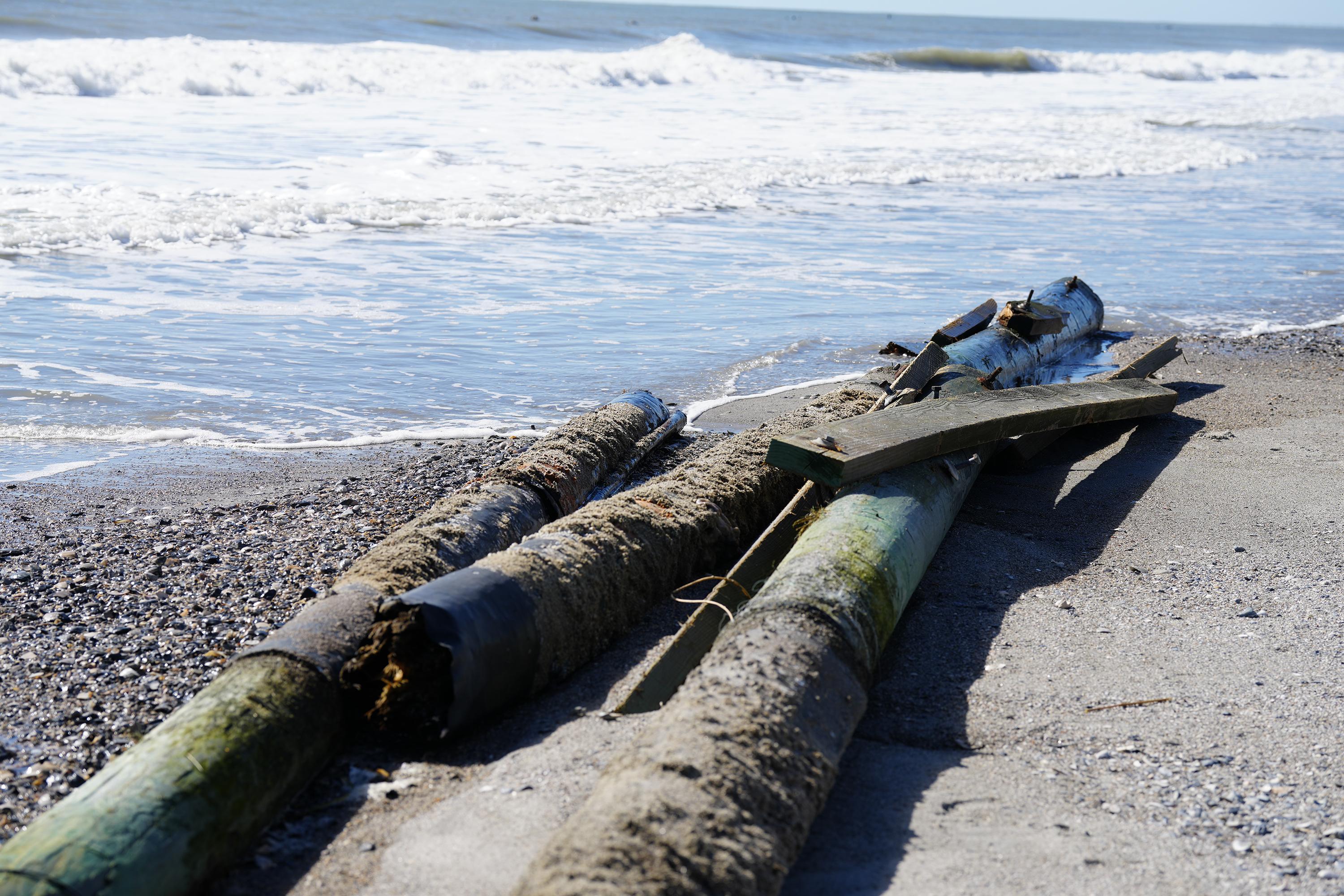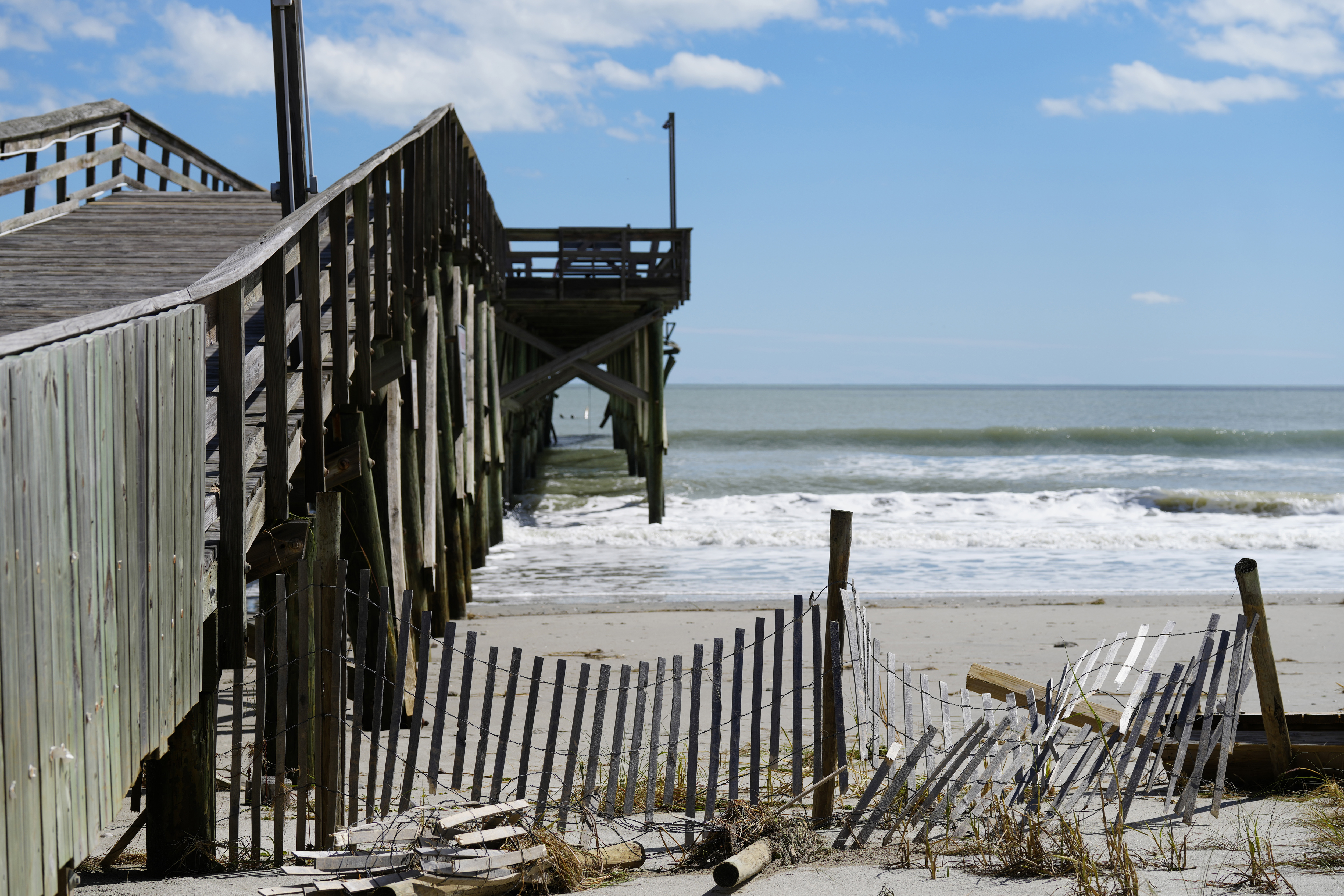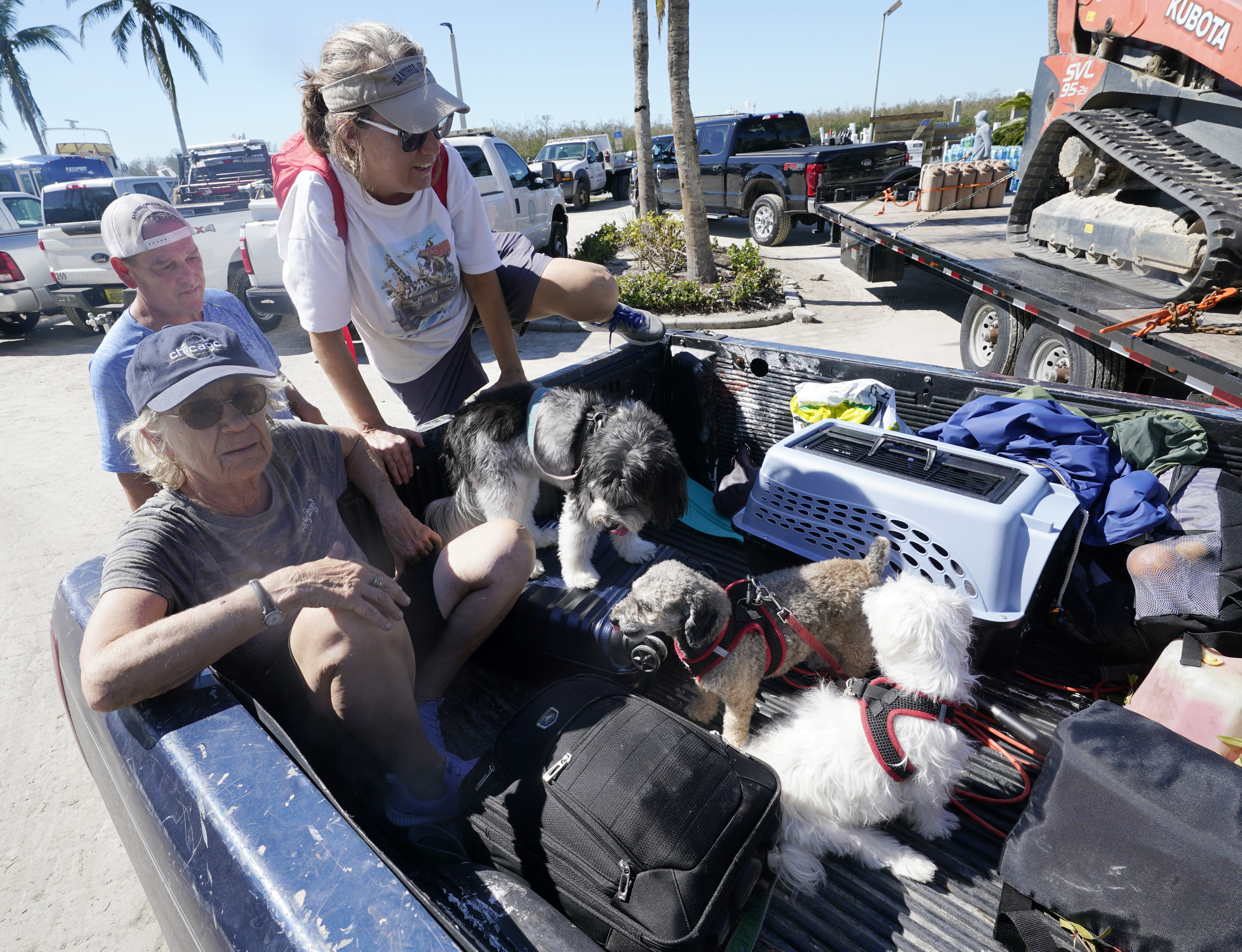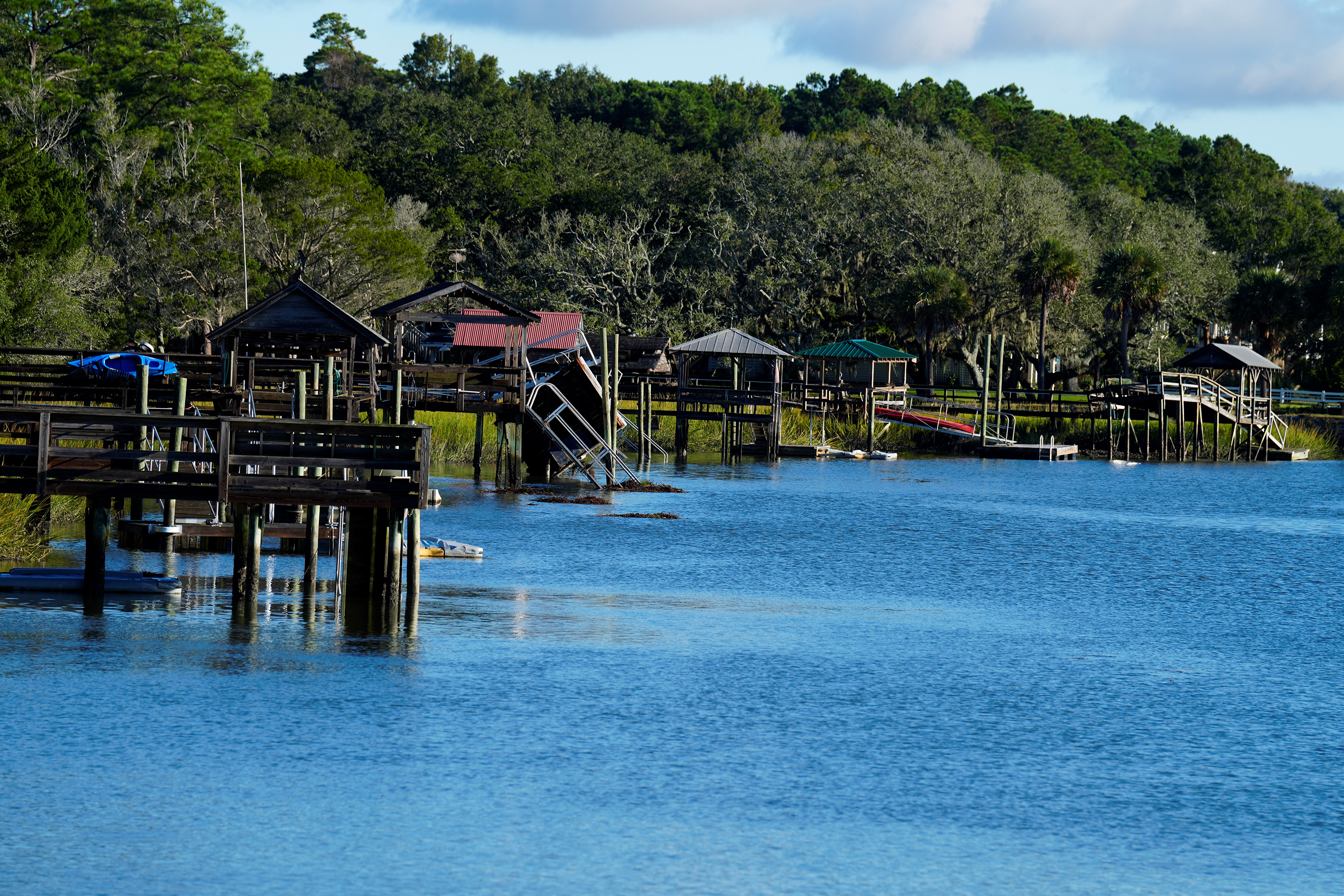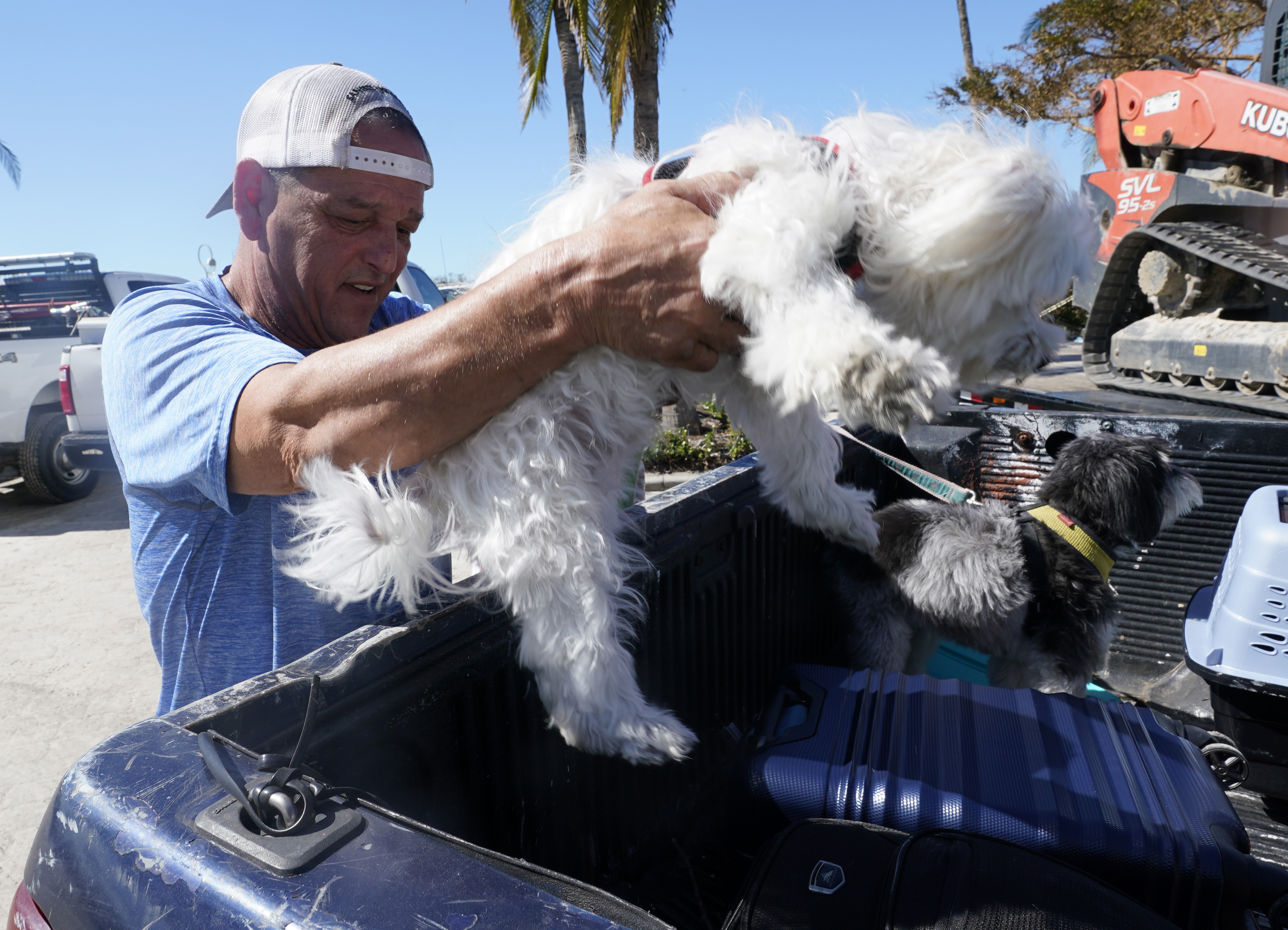FORT MYERS, Fla. -- Dozens of Florida residents left their flooded and splintered homes by boat and by air on Saturday as rescuers continued to search for survivors in the wake of Hurricane Ian, while authorities in South Carolina and North Carolina began taking stock of their losses.
The death toll from the storm, one of the strongest hurricanes by wind speed to ever hit the U.S., grew to more than four dozen, with deaths reported from Cuba, Florida and North Carolina. The storm weakened Saturday as it rolled into the mid-Atlantic, but not before it washed out bridges and piers, hurdled boats into buildings onshore and sheared roofs off homes, leaving hundreds of thousands without power.
At least 54 people were confirmed dead, including 47 people in Florida mostly from drowning but others from Ian's aftereffects. An elderly couple died after their oxygen machines shut off when they lost power, authorities said.
As of Saturday, more than 1,000 people had been rescued from flooded areas along Florida's southwestern coast alone, Daniel Hokanson, a four-star general and head of the National Guard, told The Associated Press while airborne to Florida.
On Pine Island, the largest barrier island off Florida's Gulf Coast, houses were reduced to splinters and boats littered roadways as a volunteer group went door-to-door Saturday, asking residents if they wanted to be evacuated.
Helen Koch blew her husband a kiss and mouthed the words "I love you" as she sat inside a rescue helicopter that was lifting her and seven of the couple's 17 dogs to safety.
River flooding posed a major challenge at times to rescue and supply delivery efforts.
The Myakka River washed over a stretch of Interstate 75, forcing a traffic-snarling highway closure for a while Saturday on the key corridor linking Tampa to the north with the hard-hit southwest Florida region that straddles Port Charlotte and Fort Myers.
Later Saturday, state officials said, water levels had receded enough that the interstate could be fully reopened. However, they said monitors were out keeping close watch on constantly changing river levels.
While rising waters in Florida's southwest rivers have crested or are near cresting, the levels aren't expected to drop significantly for days, said National Weather Service meteorologist Tyler Fleming in Tampa.
In southwest Florida, authorities and volunteers were still assessing the damage as shocked residents tried to make sense of the disaster.
"I want to sit in the corner and cry. I don't know what else to do," Stevie Scuderi said, mud clinging to her purple sandals as she shuffled through her mostly destroyed apartment in Fort Myers.
At Port Sanibel Marina in Fort Myers, charter boat captain Ryan Kane inspected damage to two boats Saturday. The storm surge pushed several boats and a dock onshore.
He said the boat he owns was totaled so he couldn't use it to help rescue people. Now, he said, it would be a long time before he'd be chartering fishing clients again.
"There's a hole in the hull. It took water in the motors. It took water in everything," he said. "You know boats are supposed to be in the water, not in parking lots."
On Saturday, a long line of people waited outside an auto parts store in Port Charlotte, where a sign read, "We have generators now." Hundreds of cars were lined up outside a gas station, and some people walked, carrying gas cans to their nearby cars.
THE CAROLINAS
Elsewhere, South Carolina's Pawleys Island -- a beach community roughly 75 miles up the coast from Charleston -- was among the places hardest hit. Power remained knocked out to at least half of the island Saturday.
Eddie Wilder, who has been coming to Pawleys Island for more than six decades, said Friday's storm was "insane to watch." He said waves as high as 25 feet washed away the local pier -- an iconic landmark -- near his home.
"We watched it hit the pier and saw the pier disappear," said Wilder, whose house 30 feet above the ocean stayed dry inside. "We watched it crumble and and watched it float by with an American flag."
The Pawleys pier was one of at least four along South Carolina's coast destroyed by battering winds and rain. Parts of the pier, including barnacle-covered pylons, littered the beach. The intracoastal waterway was strewn with the remnants of several boat houses knocked off their pilings.
In North Carolina, the storm claimed four lives and mostly downed trees and power lines, leaving over 280,000 people statewide without power Saturday morning, officials said.
In Johnston County, outside Raleigh, a woman found her husband dead early Saturday morning after he went to check on a generator running in their garage overnight, sheriff's office Capt. Jeff Caldwell said.
Carbon monoxide levels also were high inside the home, and the woman was checked out at a hospital, according to Caldwell.
Also in Johnston County, two young adults died in traffic collisions during stormy and wet conditions Friday, Gov. Roy Cooper's office said in a news release. In eastern North Carolina's Martin County, a 22-year-old man drowned when his truck left the roadway and submerged in a flooded swamp, the news release said.
"We mourn with the families of those who have died and urge everyone to be cautious while cleaning up to avoid more deaths or injuries," Cooper said in a statement.
The highway patrol responded to over 1,400 calls for service and 784 collisions between midnight Friday and early Saturday, a spokesman said. Not all were necessarily weather-related.
There were no initial reports of major structural damage, though nearly 73,000 people across the state were without power Saturday evening, according to a state outage map. That was down from over 330,000 earlier in the day.
REBUILDING THE GRID
Crews are beginning to repair -- and in some cases, rebuild -- Florida's power grid after the state was pummeled by Hurricane Ian.
Florida Power & Light says it stockpiled enough poles, generators and wire to do the work. But power-industry officials warn that kinks in the nation's supply chain could slow the recovery if Ian causes more damage as it spins up the Atlantic coast, or when another natural disaster strikes somewhere else in the United States.
Eric Silagy, CEO of Florida Power & Light, said Friday evening 850,000 of the utility's customers who lost power in the storm remained without power, but 1.2 million had power restored during the day.
Silagy said last week the company had set aside enough generators in the months before Ian to complete repairs.
Nationally, however, there is a shortage of distribution transformers that take electricity from high-voltage lines and reduce it to levels that can be used in homes and businesses, industry officials said.
It used to take about three months for a transformer to show up after being ordered, but now it is taking more than a year, said Joy Ditto, president and CEO of the American Public Power Association. She said that is limiting the ability of companies to stockpile the boxes, and as a result, they are increasingly swapping boxes with utilities facing a shortage.
There are about a half-dozen U.S. manufacturers of the transformers that are dealing with labor and raw-materials shortages. Ditto said the main choke point is the specialty steel used in transformers -- there is only one U.S. manufacturer for that.
Her group and the National Rural Electric Cooperative Association asked the Energy Department in May to suspend a 2016 efficiency standard that they say is partly responsible for the steel shortage, but the department has not gone along.
Scott Aaronson, an official at the Edison Electric Institute, which represents for-profit utilities, said the industry is prioritizing supplies during hurricane and wildfire season.
"These efforts help to ensure we are ready to share materials with companies impacted by Hurricane Ian if necessary," he said by email.
WATER WOES
Some of the most potent problems in Florida were less easy to see, including the effect on water systems, as the electricity needed to keep water flowing went out in some areas, and water lines were severed by the storm.
The state's water troubles were reflected on a regularly updated list of boil-water advisories maintained by the Florida Department of Health. On Monday, it had no such notices to report. On Friday, there were nearly 50 advisories in effect.
"As far as I'm aware, every single case is related to the hurricane," Jae Williams, a Health Department spokesperson, said Friday.
Boil-water advisories, which alert residents to the possibility of biological contamination in a water system, can be issued for a number of reasons and are often prompted by malfunctions or damage that results in a loss of pressure or other problems. Residents at low elevations are typically told to boil any water used for drinking or cooking for at least one minute.
But in some of the hardest-hit places, water was not coming out of the taps. And owners of electric stoves had limited options in a state where more than 1.7 million power customers were without electricity as of Friday afternoon.
Some of the areas on the boil-water list were small, such as the Spanish Main Travel Resort, a recreational vehicle park in Hillsborough County, on the western side of the state. In other cases, the advisories covered entire cities, like Bartow, Fla., a city of about 20,000 where the water system experienced several line breaks.
The Federal Emergency Management Agency announced Friday that it had sent 422,675 million gallons of water to Florida and promised that another 1.74 million gallons were on the way. The water was part of an enormous federal response focused on providing basic human services, including 5.5 million meals, more than 400 ambulances and four aircraft to evacuate medically vulnerable people from nursing homes and other facilities.
But the worst trouble was in Lee County, where a badly damaged water system was affecting a population of nearly 760,000, forcing residents to hunt through a tableau of ruin for bottled-water distribution sites and forcing state and federal officials to improvise some creative solutions.
The problem was affecting institutions as well as residents. As of Friday morning, three hospitals in Lee County were without water, forcing administrators to evacuate some patients, said Mary Mayhew, CEO of the Florida Hospital Association.
Later in the day, however, Kevin Guthrie, director of the Florida Division of Emergency Management, said in a news conference the state had "solved the water problem temporarily" by setting up tanks at the hospitals and "ferrying 20,000 gallons of water about five times a day" to each hospital.
Guthrie also said more than 14,000 gallons of diesel fuel had been shipped to Fort Myers for use at a water plant that served the hospitals.
The water challenges were different farther inland.
In Polk County, in Central Florida, Ian left thousands of people without power. Also without power Friday morning were 55 of the county's 350-plus "lift stations," which pump wastewater to the local treatment plant.
Mark Addison, a manager for utilities in Polk County, said one short-term solution was to warn people to conserve water and not overwhelm a system that could send dirty water back through their pipes and into their homes.
The ultimate solution -- which speaks to another looming infrastructure challenge for Florida -- was to work to get the power back on quickly.
Information for this article was contributed by Rebecca Santana, Meg Kinnard, Freida Frisaro, Brendan Farrington, Gerald Herbert, Mike Pesoli, Sarah Rankin, David Koenig and staff members of The Associated Press and by Campbell Robertson and Richard Fausset of The New York Times.
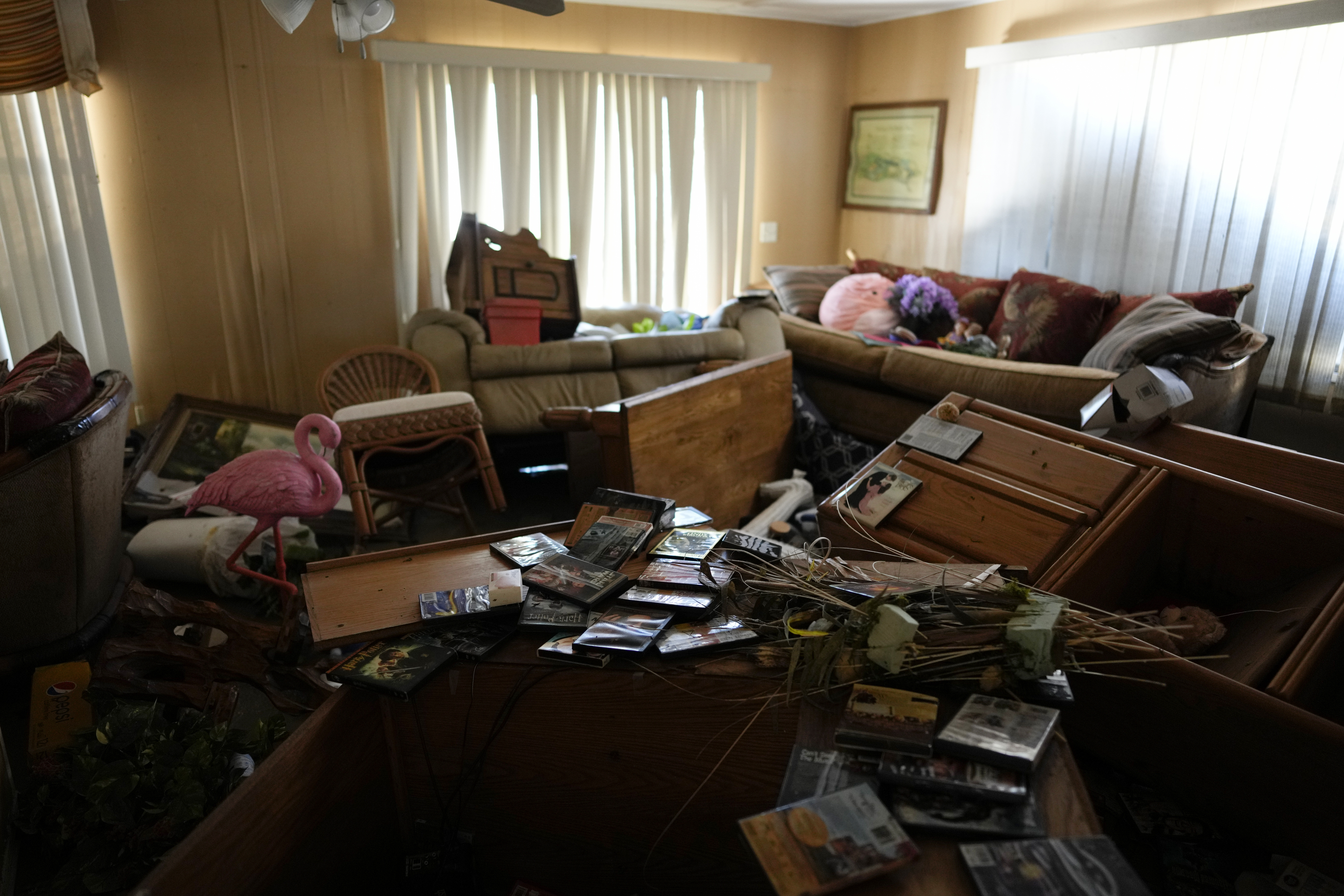 Furniture and personal items lie jumbled in the living room of Nita Ross, 79, as she returns to her mobile home for the first time since the passage of Hurricane Ian, at the Sunshine Mobile Home Park in Fort Myers, Fla., Saturday, Oct. 1, 2022. Ross' home stayed on its foundations, unlike those of some of her neighbors, but storm flooding almost to the height of the ceiling destroyed most of her possessions and household items. (AP Photo/Rebecca Blackwell)
Furniture and personal items lie jumbled in the living room of Nita Ross, 79, as she returns to her mobile home for the first time since the passage of Hurricane Ian, at the Sunshine Mobile Home Park in Fort Myers, Fla., Saturday, Oct. 1, 2022. Ross' home stayed on its foundations, unlike those of some of her neighbors, but storm flooding almost to the height of the ceiling destroyed most of her possessions and household items. (AP Photo/Rebecca Blackwell)Gallery: After-effects of Hurricane Ian
